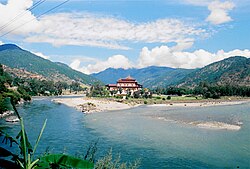| Pho Chhu | |
|---|---|
 Confluence of the Mo Chhu (left) and the Pho Chhu (right) | |
| Location | |
| Country | Bhutan |
| District | Punakha |
| Physical characteristics | |
| Source | Tarina Tsho |
| • location | Gasa District |
| Mouth | Brahmaputra |
| Basin features | |
| Bridges | Pho Chhu Suspension Bridge |
Pho Chhu (Male River) is one of the major rivers of Bhutan,[1] which tracks its source to Gasa District on the borders between Bhutan and Tibet. It joins with the Mo Chhu (Female River) at the confluence below Punakha Dzong, the winter residence of Dratshang Lhentshog. Upon Dang Chhu joining below Wangdue Dzong, the trio flows as Puna Tsang Chhu and finally empties into the Brahmaputra, upon being joined by several tributaries on its course through the valley of Assam. Its source is susceptible to glaciers which even destroyed a part of Punakha Dzong.[2]
References[edit]
- ^ "Lower Pho Chhu". Whitewater Guidebook. 2014-11-17. Retrieved 2020-06-11.
- ^ Wangdi, Rinzin; Windischgraetz, Michaela (2019-06-01). "The Black-Slate Edict of Punakha Dzong". Rochester, NY. doi:10.2139/ssrn.3537406. S2CID 239302816. SSRN 3537406.
{{cite journal}}: Cite journal requires|journal=(help)
Well, that’s interesting to know that Psilotum nudum are known as whisk ferns. Psilotum nudum is the commoner species of the two. While the P. flaccidum is a rare species and is found in the tropical islands. Both the species are usually epiphytic in habit and grow upon tree ferns. These species may also be terrestrial and grow in humus or in the crevices of the rocks.
View the detailed Guide of Psilotum nudum: Detailed Study Of Psilotum Nudum (Whisk Fern), Classification, Anatomy, Reproduction